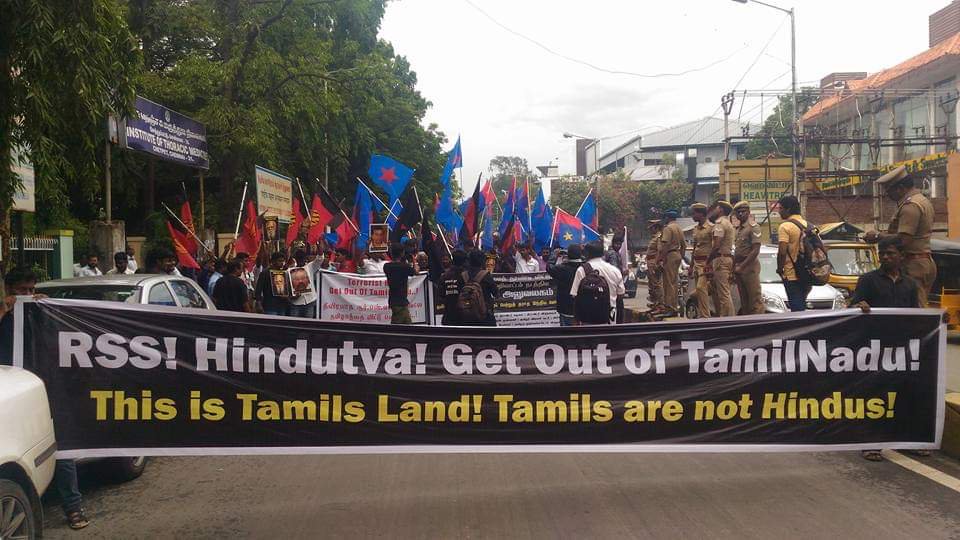PJ Cherian, Pattanam excavator and who currently heads an NGO PAMA in Kerala, says he had an on-hand documentation of the Kodumal, Alagankulam, Korkai and Pattaraiperumbudur excavated materials from Tamil Nadu (Do ancient Tamilakam sites deserve rediscovery?, The Times of India, Nov.30, 2018). How did his NGO get easy access to the excavated material from these Tamil Nadu sites in government possession? It has enabled Cherian for identifying similarities with Pattanam and Tamil Nadu sites to claim that there is a common link of ‘brotherhood’ (Pattanam, Keezhadi excavated materials similar, says expert, Deccan Chronicle, Oct. 31, 2018). This issue cannot be viewed lightly, especially when Pattanam site has close ties with British Museum. The museum has not actively participated in such excavations elsewhere in India.
Earlier, delivering a lecture at Chennai, PJ Cherian claimed that the excavated materials from Pattanam and Keezhadi are similar. However, he did not present either ceramics, metals or any other remains showing the cultural homogeneity between Pattanam and Keezhadi.
In 2016, the Ministry of Home Affairs (MHA) identified the unbridled foreign funds received by KCHR and cancelled its licence under the Foreign Contribution Regulation Act 2010. (The New Indian Express, Dec. 8, 2016). We accuse R Sivanantham, deputy director, Tamil Nadu State Dept. of Archaeology who should have been aware that the KCHR was accused in creation of fake government documents, illegal appointments and financial irregularities worth crores. Sivanatham who is also current excavator of Keezhadi invited the controversial Pattanam project director to deliver a lecture where he made dubious claims that there are many similarities between the two sites.
When the Archaeological Survey of India began a probe into alleged unscientific approaches adopted by the KCHR at Pattanam, Amarnath Ramakrishna, the then superintendent archaeologist of the ASI, Bengaluru centre, started investigations into the Pattanam excavations (ASI probe into KCHR’s ‘Pattanam excavations’, Business Standard, Jan. 5, 2016). His findings are not known, but later Amarnath Ramakrishna took up the Keezhadi excavation. Possibly, he prepared a report liked by the CPI(M) and left historians. As Amarnath Ramakrishna examined the Pattanam excavation report and was in-charge of Keezhadi, the Left lobbies have been able to notice striking similarities in antiquarian remains from the two sites.
In April 2018, the Federation of Tamil Sangams in North America (FeTNA) invited Amarnath Ramakrishna to deliver a lecture on the Keezhadi excavations. The ASI denied him permission to participate as guest of honor at this event, possibly because FeTNA publicly supported the cause of ethnic Sri Lankan Tamils in the Sri Lankan civil war. The Catholic Church is heavily involved with the LTTE from the 1970s .
Prof K Rajan of Pondicherry University marshals the cause of Pattanam in Tamil Nadu and associates it with recently excavated sites in the state. Along with Cherian, he links Pattanam with Kodumanal, Thandikudi, Porunthal Keezhadi and other archaeological sites in Tamil Nadu. Rajan is well aware of the duplicity on Pattanam and its Biblical agenda. It now raises serious doubts on sites in Tamil Nadu which he excavated and constantly associates Pattanam. Rajan is also closely associated with British Museum which contains looted treasures of colonized counties.
Pattanam is strongly claimed by its excavator as the landing site of St’ Thomas. Currently Tamil Nadu Catholic priest PJ Lawrence Raj has written many letters to the bishops of the Catholic world seeking brand recognition for St. Thomas in Tamil Nadu whom he claims is largely credited for bringing Christianity to India. Fr. Raj put hard efforts to bring St. Thomas back to the mainstream narrative of Chennai’s Roman Catholic world (An apostle returns: Bringing St. Thomas back to Chennai, The Hindu, Oct.27, 2018). What is now needed are some major archaeological sites in Tamil Nadu to get affiliated with the Apostle.
Tamil Nadu is one of the major areas in India which receives huge foreign funds through NGOs (Independent churches mushroom across India attracting foreign funds, India Today, April 30, 2011 and Christian NGOs top in foreign funding, The Times of India, March 20, 2017). Mathew Cherian, Chairperson of Voluntary Action Network India says, southern states top in receiving foreign funds due to number of Christian organizations, and Tamil Nadu gets chunk of such funds (Foreign funds pour in; 3,000 NGOs get over Rs. 22,000 cr., The Hindu, Aug. 2, 2016). All these orchestrated campaigns by NGOs using history and archaeology to establish Apostle Thomas in Tamil Nadu have to be understood considering these factors.





